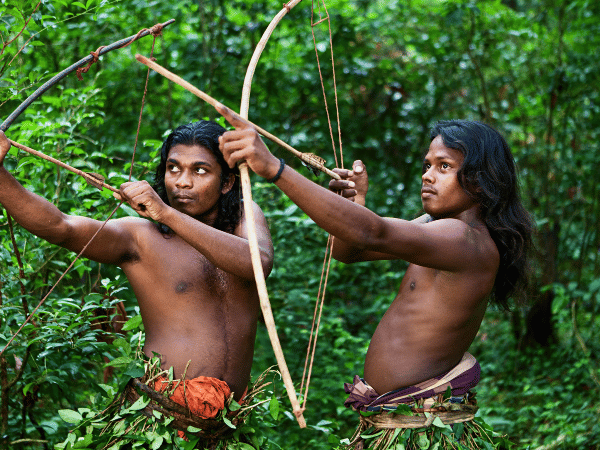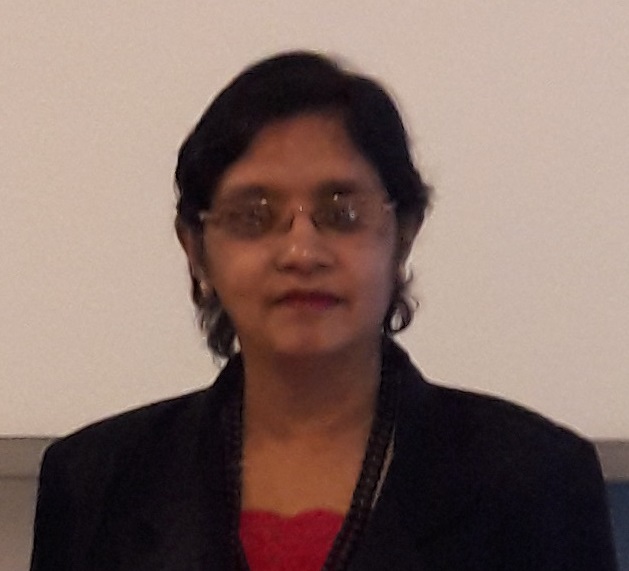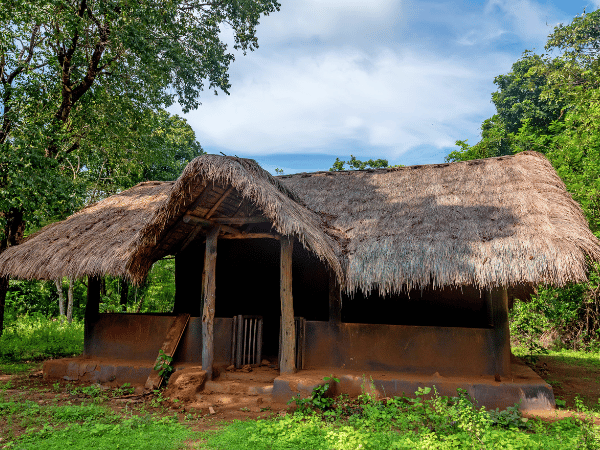Lesser-known Forest Dwellers of Rathugala
– By Arundathie Abeysinghe

 Inhabiting in the distant village Rathugala, (situated in close proximity to *Gal Oya National Park, approximately 30 kilometers from *Ampara), amidst a diverse woodland, these forest dwellers known as “Rathugala *Veddas” are lesser-known indigenous people of Sri Lanka. They live in the diminishing forests of Sri Lanka. Rathugala is a small hamlet of 110 families living adjacent to the forest. These indigenous people had originally lived in caves in *Danigala Rock area.
Inhabiting in the distant village Rathugala, (situated in close proximity to *Gal Oya National Park, approximately 30 kilometers from *Ampara), amidst a diverse woodland, these forest dwellers known as “Rathugala *Veddas” are lesser-known indigenous people of Sri Lanka. They live in the diminishing forests of Sri Lanka. Rathugala is a small hamlet of 110 families living adjacent to the forest. These indigenous people had originally lived in caves in *Danigala Rock area.
During the early 1950s, some people of the indigenous community in Danigala Rock area were relocated due to the construction of the *Senanayake Samudhraya to irrigate the arid farmlands of the East and South East of Sri Lanka. Several years later, due to a ban on hunting imposed by the Government, the other inhabitants had also moved to Rathugala.
According to scholars, the bloodline of Rathugala indigenous people traces to the era of *Kuweni. They hail from a generation known as “Mahabandala.” These people had arrived in Rathugala in the 1930s. Since that period, they have been living in the area. For generations, the leadership of the clan has been carried from father to son.
Earlier, they had been hunter-gatherers. Yet, at present, they do not live in caves nor their sole occupation is the indigenous lifestyle of hunting. Instead, they are mostly engaged in cultivation, growing crops such as corn, tubers or engaged in paddy cultivation. Yet, they are still connected with the forests and frequently venture into the forests to collect bees honey. The females of the clan go to the forest in search of edible fruits, leaves, medicine and to collect firewood for cooking. During the period of harvesting, all inhabitants of the hamlet engage in the process and the produce is equally distributed among all the families by the head of the clan.
Their dwellings are simple wattle and daub houses with roofs thatched with *iluk grass.
They have a simple lifestyle, a simple symbiotic existence with the forest. Modern-day advanced technology is hitherto unknown to them.
In the small garden of the majority of houses, there is a small shrine room with a Buddha Statue. Flowers are offered at the shrine room by the inhabitants. In certain shrine rooms, there are statues of deities, considered as those protecting the village.
At present, youths of the hamlet have left to cities in search of job opportunities. Hence, in future, their culture, customs, way of life and habits may disappear.

Scholars are of the view that Rathugala indigenous lineage is not related to well-known indigenous communities of Dambane, although, they maintain friendly relations with them. The two indigenous groups share similarities in language including the symbolic axe borne on the shoulder. Marriages between these two communities also occur frequently.
- Ampara – Located in the Eastern Province of Sri Lanka 360 kilometers east of Colombo, Ampara is the main town of Ampara District.
- Chena cultivation – This is a traditional form of cultivation which extends as far as 5000 years, the oldest form of faming in Sri Lanka. In the past, each village had a chena. Vegetables, cereals as well as green leaves are cultivated in a chena.
- Gal Oya National Park – Established in 1954, Gal Oya National Park serves as the main catchment area for Senanayake Samudraya, the largest reservoir in Sri Lanka constructed under the Gal Oya Development Project. Situated in south east of Sri Lanka with an extent of 25900 hectares, a highlight of the Park is the frequent sighting of elephants swimming from one island to another. As the Park borders a reservoir, there are many little islands in the vicinity and it is the only National Park in Sri Lanka where visitors can go on a boat safari.
- King Vijaya (c. 543 – c. 505 BCE) – According to *Mahawamsa, he was the first Sinhalese king. Indian and Sri Lankan legends and records indicate that he and several hundred followers arrived in Sri Lanka after they were banished from Sinhapura (Sinhapura – transliterated as Sihapura or Singhapura – capital of the legendary Indian King Sinhabahu) in India.
- Kuweni – According to genesis myths recorded in Mahawamsa, she was the first wife of King Vijaya (Sri Lanka’s first recorded king). Also known as “Kuwanna” and “Sesapathi”, she was from a *Yaksha clan. Kuweni and *King Vijaya had two children, a son and a daughter. According to chronicles, Sri Lanka’s indigenous people known as “*Veddas” are descendants of Kuweni’s children who fled to the forest after Kuweni was abandoned by King Vijaya.
- Iluk grass (Imperata cylindrica) – Also known as “spear grass” is a species of perennial rhizomatous grass native to tropical and subtropical Asia, Micronesia, Melanesia, Australia, Africa, and southern Europe. At present, Iluk grass is also prevalent in Latin America, the Caribbean and the southeastern United States.
- Mahawamsa – “Great Chronicle” or “Great Dynasty” in Sinhala is the most significant work of Sri Lankan origin written in Pali Language. This Chronicle describes life and times of Sri Lankans from the arrival of Vijaya in 43 BC to the reign of King Mahasena from sixth century BC to fourth century AD. Culawamsa (lesser chronicle) covers the period from fourth century AD to British takeover of Sri Lanka in 1815. Mahawamsa consists of three parts covering a historical record of over two millennia. It is considered as the world’s longest unbroken historical record.
- Senanayake Samudhraya – Located in Ampara District and initially, known as “Galoya Reservoir”, it is known as “the sea” by locals due to its enormous size. With a capacity of 950,000,000m3, it is considered as the biggest reservoir and man-made lake in Sri Lanka as well as one of the most iconic reservoirs constructed during the post-independence era. The Reservoir was completed in 1953 during the period of Prime Minster D. S. Senanayake (Don Stephen Senanayake, the first Prime Minister of Ceylon, present Sri Lanka).
- Veddas – Also spelt as Veddhas and currently known as “Adivasi” or “Wanniyalaeto”, they are a minority indigenous group of people in Sri Lanka. They were Sri Lanka’s (former Ceylon) aboriginal inhabitants prior to the 6th century bce and take immense pride in an age-old lifestyle of hunting and collecting firewood from the forest. According to anthropologists, their origins are much older; with some anthropologists dating them to the Stone Age. Veddas have a long history of living harmoniously with nature. There are three predominant types of Veddas: Gal Veddas (cave-dwellers who lived in caves), Muhudu (meaning sea in Sinhala) Veddas also known as Coastal Veddas (who lived on the coastline) and Gam Veddas (Gam meaning village in Sinhala) also known as village Veddas (who predominantly engaged in *Chena Cultivation and lived in small huts in village communities).
- Yaksha – A broad class of nature-spirits, usually benevolent, yet, occasionally capricious, and considered as guardian deities connected with treasure, water, fertility, trees, forests and wilderness. The feminine form of “Yaksha” is “yakshi” or “yakshini” (Sanskrit). They appear in Buddhist, Hindu and Jain texts as well as in ancient and medieval era temples of South Asia and Southeast Asia.
Danigala Circular Rock – miraculous inselberg
By Arundathie Abeysinghe
November 3, 2021
https://www.elanka.com.au/danigala-circular-rock-miraculous-inselberg-by-arundathie- abeysinghe/







